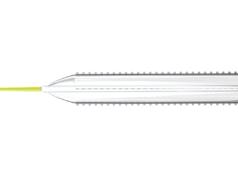Preliminary 30-day data from the PRELUDE trial investigating the use of the Serranator Alto percutaneous transluminal angioplasty (PTA) serration balloon catheter (Cagent Vascular) have shown 100% technical success and good effectiveness in moderate to severe calcification in the superficial femoral artery. The acute results show that the balloon can achieve low residual stenosis, and final six-month results are expected by the end of 2017.
Marianne Brodmann (Graz, Austria) presented the 30-day data at the Vascular Interventional Advances 2017 conference (VIVA; 11–14 September, Las Vegas, USA) on behalf of the PRELUDE investigators. She explained that the Serranator Alto balloon has four embedded serrated stainless steel strips, designed to create linear, interrupted lines of scoring along the endothelial surface as the balloon inflates. Responsive to the balloons energy, these serrations enable predictable and controlled lumen expansion as serrated material is more responsive to directed energy.
Discussing the data on behalf of the PRELUDE investigators during a VIVA press conference session, Peter Schneider (Honolulu, USA)—co-founder of Cagent Vascular—explained the concept behind the serrations. “What we have now are balloons that apply an equal amount of force in all directions. Nowhere in your life do you take that approach. You want to be more specific, and this serration approach allows the balloon to do that.”
The PRELUDE study is a single-arm, prospective, multicentre, core-lab adjudicated feasibility study enrolling patients with superficial femoral or popliteal lesions. Follow-up is to be conducted at 30 days and six months. The primary objective is to evaluate the technical feasibility of the Serranator Alto in these patients, while the secondary objective is the optical coherence tomography (OCT) and intravascular ultrasound (IVUS) evaluation of the presence of serrations across the treated lesions in a 10-patient subset.
The primary safety endpoint is a composite of major adverse events and periprocedural death at 30 days post-procedure. The primary efficacy endpoint is the rate of successful delivery, inflation/deflation, and device retrieval with a final diameter stenosis <50% by visual assessment at the intended target site using only the device.
Patients with stenosis >70%, lesion length ≤10cm and reference vessel diameters of 4–6mm were included, and occlusions up to 6cm long were allowed. Twenty-five patients were enrolled at four centres. Moderate or severe calcification was present in 56% (n=14) of subjects, and 32% (n=8) had total occlusions.
The average pre-treatment stenosis was 88% and post-treatment was 23%. Only one stent (4%) was placed post-Serranator. No major adverse events or perioperative deaths were reported at 30 days. Serration effect was confirmed by the independent core lab in all OCT and IVUS images (n=10).
Brodmann explained that these preliminary data indicate that the Serranator Alto “is safe and effective in treating critical femoropopliteal lesions.”












